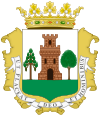Plasencia
| Plasencia | |||
|---|---|---|---|
| Municipality | |||
| plasencia | |||

Top:Plasencia Nova Cathedral, Second left:Casa Consistorial (Consistorial House), Second right:Palacio dos Monroy (Monroy Palace), Third left:Muralhas de Plasencia (Plasencia Defensive Wall), Third right:Jerte River, Bottom:Apueduto de San Anton (Aqueduct of San Anton)
|
|||
|
|||
| Location in Spain | |||
| Coordinates: 40°02′N 06°06′W / 40.033°N 6.100°W | |||
| Country |
|
||
| Autonomous community |
|
||
| Province | Plasencia | ||
| Comarca | Valle del Jerte | ||
| Government | |||
| • Mayor | Fernando Pizarro (PP) | ||
| Area | |||
| • Total | 218 km2 (84 sq mi) | ||
| Elevation | 415 m (1,362 ft) | ||
| Population (2013) | |||
| • Total | 41,047 | ||
| • Density | 190/km2 (490/sq mi) | ||
| Demonym(s) | Placentino/a | ||
| Time zone | CET (UTC+1) | ||
| • Summer (DST) | CEST (UTC+2) | ||
| Postal code | 10600 | ||
| Website | www |
||
Plasencia is a walled market city in the province of Cáceres, Extremadura, Western Spain. As of 2013[update], it has a population of 41,047.
Situated on the bank of the Jerte River, Plasencia has a historic quarter that is a consequence of the city's strategic location along the Silver Route, or Ruta de la Plata. Since the 15th century, the noblemen of the region began to move to Plasencia, defining its current appearance.
Although Plasencia was not founded until 1186, pieces of pottery found in Boquique’s Cave provide evidence that this territory was inhabited long before. Pascual Madoz's dictionary details that this ancient territory, either called Ambroz or Ambracia, was originally given the name Ambrosia before becoming Plasencia.
In the same year that the city was founded, Alfonso VIII of Castile gave the city its independence and the Diocese of Plasencia was created. The original motto of the city, Ut placeat Deo et Hominibus, means to please God and man. Ten years after its birth, Plasencia was taken over by the Almohad Caliphate, a Moroccan Berber-Muslim dynasty that dominated the Iberian peninsula throughout much of the 12th century. King Alfonso VIII and his forces recaptured the city within the same day.
At the end of the 13th century, the Charter of Plasencia was created, allowing the Christian, Muslim and Jewish people to live peacefully together within the city. This charter prompted the formation of a Jewish community in Plasencia, which became the largest Jewish community in Extremadura at that time and held a considerable amount of economic power.
The 15th century was a vital period in Plasencia’s history, because it was at this time that a jurisdiction of lordship was established. In 1442, King John II of Castile gifted the city to the House of Zúñiga and its right to vote in the Cortes of Castile was lost. In 1446, the first university in Extremadura was installed in Plasencia, according to the wish of the Bishop. As a result, everyone from the surrounding areas who could afford to study in the university moved to Plasencia.
...
Wikipedia



